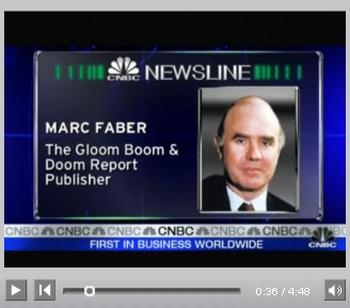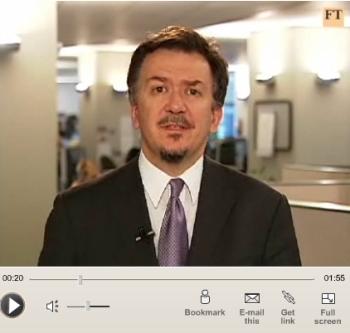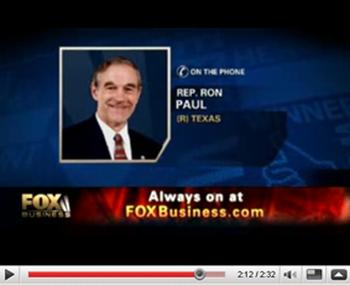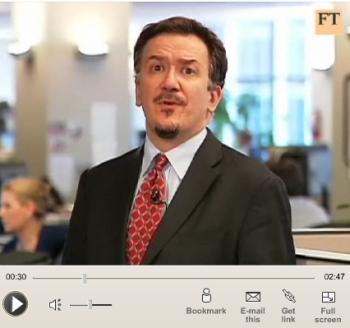Stock Market Crash Bloodbath Frustration
Stock-Markets / Financial Crash Oct 12, 2008 - 12:23 PM GMT


 I have been away from the trading desk, and the stock market's bloodbath, during the past few days as I am on a business visit in Geneva. Just as well, but I can nevertheless associate with the frustration of the trader in the animated image (hat tip: Rob Fraim).
I have been away from the trading desk, and the stock market's bloodbath, during the past few days as I am on a business visit in Geneva. Just as well, but I can nevertheless associate with the frustration of the trader in the animated image (hat tip: Rob Fraim).
In order to allow me a bit of extra time to consult with the Suisse gnomes (disguised as private bankers), I am only doing a shortened version of “Words from the Wise” this week. Although I have managed to compile some very interesting excerpts from news items and quotes from market commentators, I will not be doing my customary review of the financial markets' movements and economic statistics.
Confusion and irrational fear characterized financial markets during a remarkable week, with the CBOE Vix Index (the so-called “fear gauge”) spiking above 70 for the first time. According to data from Bespoke , the week's US stock market crash of 18.2% ranks second as the worst Monday-to-Friday movement for the Dow Jones Industrial Average since 1900. Amid the dumping of stocks on all bourses, the US dollar, Japanese yen and precious metals were the only safe havens. (Also see related posts: Stock market performance round-up: Crash of 2008 and Stock market decline in perspective .)
The realization that the economic damage from the credit crisis was intensifying weighed on investor sentiment. Selling of equities therefore persisted despite a litany of initiatives announced by governments and central banks around the globe, aiming to boost liquidity and restore confidence in the banking system.

Source: Slate
The media headlines were cluttered with reports of various actions being taken to alleviate the financial turmoil (as dealt with comprehensively in the news section of this post). However, none was as succinctly formulated as that of the Central Bank of Jamaica (hat tip: Barry Ritholtz's The Big Picture ).
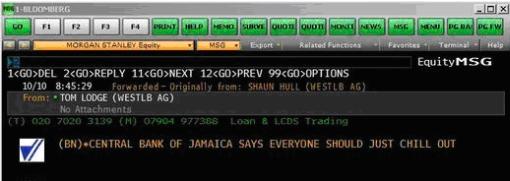
Next, a tag cloud of the text of the plethora of articles I have read during the past week. This is a way of visualizing word frequencies at a glance. As the saying goes: A picture paints a thousand words …
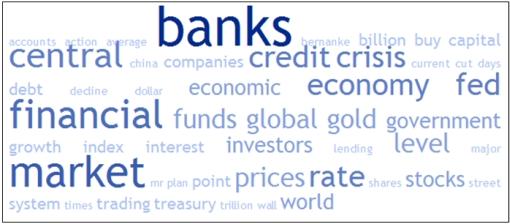
As far as the outlook for stocks is concerned, Paul Kedrosky ( Infectious Greed ) said: “I am trying very hard to look through all of this to see what things look like on the other side. And I can see faint outlines, for sure, but that other shore still seems awfully far away.”
On the other hand, Tim Bond, head of global asset allocation at Barclays Capital, was quoted in the Financial Times as saying: “We believe global equity markets are starting to offer a long-term buying opportunity that is typically only seen once in a generation. We are not calling the bottom in the bear market today, but we do suggest that the low will be seen within the next two or three weeks.”
Bond also suggested that returns from equities purchased during this interval may well be extremely higher over the next year and could – if history is any guide – turn out double-digit long-term returns over the next decade.
As a sign of these extraordinary times, mulling through my head at the moment are the lyrics of Peter Gabriel's song “Perspectives”: “I need perspective, ‘cos I'm facing the wall. I need perspective, ‘cos I'm not that tall. I need perspective, heard the trumpet call. Don't trust my eyes, want to know where things fall.”
Having said that, I yesterday summarized my views in a post as follows: “Nobody really knows what happens next, although some indicators are starting to signal that a bounce may not be all that far off. But stock markets are unlikely to find a cycle low before measures are implemented to stem the decline in confidence. It may take a while yet before we see the bear's corpse, but look out for a 90% up-day as a signal of the completion of the selling climax.”
Economic reports
Click here for the week's economy in pictures, courtesy of Jake of EconomPic Data .
Date |
Time (ET) |
Statistic |
For |
Actual |
Briefing Forecast |
Market Expects |
Prior |
| Oct 7 | 3:00 PM | Consumer Credit | Aug | -$7.9B | $5.2B | $5.0B | $5.2B |
| Oct 8 | 10:00 AM | Pending Home Sales | Aug | 7.4% | - | -1.2% | -2.7% |
| Oct 8 | 10:35 AM | Crude Inventories | 10/04 | 8123K | NA | NA | 4278K |
| Oct 9 | 8:30 AM | Initial Claims | 10/04 | 478 | 475K | 475K | 498K |
| Oct 9 | 10:00 AM | Wholesale Inventories | Aug | 0.8% | 0.5% | 0.4% | 1.5% |
| Oct 10 | 8:30 AM | Export Prices ex-ag. | Sep | . | NA | NA | NA |
| Oct 10 | 8:30 AM | Import Prices ex-oil | Sep | - | NA | NA | NA |
| Oct 10 | 8:30 AM | Trade Balance | Aug | - | -$58.0B | -$59.0B | -$62.2B |
Source: Yahoo Finance , October 10, 2008.
In addition to Fed Chairman Ben Bernanke speaking at the Economic Club of New York on Wednesday, October 15, next week's economic highlights, courtesy of Northern Trust , include the following:
1. Retail Sales (October 15): Auto sales dropped to an annual rate of 12.5 million in September from 13.7 million in August. Non-auto retail sales are expected to show noticeable weakness. Reflecting these aspects, the headline retail sales number is projected to have fallen 0.7% in September after a 0.3% drop in August. Consensus : -0.6% versus -0.3% in August, non-auto retail sales: -0.3% versus -0.7% in August.
2. Producer Price Index (October 15): The Producer Price Index for Finished Goods is predicted to have dropped 0.4% in September reflecting lower energy prices, while the core PPI most likely moved up 0.1%. Consensus : -0.4%, core PPI +0.2%.
3. Consumer Price Index (October 16): A 0.1% increase in the CPI is our forecast for September following a 0.1% drop in August. The core CPI is expected to have moved up 0.1% after a 0.1% gain in August. Consensus : +0.1%, core CPI +0.2%.
4. Industrial Production (October 16): The 1.0% drop in the manufacturing man-hours index in September suggests a 0.8% decline in industrial production. The operating rate is projected to have dropped to 77.9 in September. Consensus : -0.8%; Capacity Utilization: 77.9 versus 78.7 in August.
5. Housing Starts (October 17): The elevated level of inventories of unsold new homes points to another monthly drop in housing starts (870,000 versus 895,000 in August). Consensus : 880,000.
6. Other reports : Inventories (October 15), NAHB Survey, Philadelphia Fed Survey (October 16), Consumer Sentiment Index (October 17).
Click here for a summary of Wachovia's weekly economic and financial commentary.
A summary of the release dates of economic reports in the UK, Eurozone, Japan and China is provided here . It is important to keep an eye on growth trends in these economies for clues on, among others, the trend of the US dollar.
Markets
The performance chart obtained from the Wall Street Journal Online shows how different global markets performed during the past week.
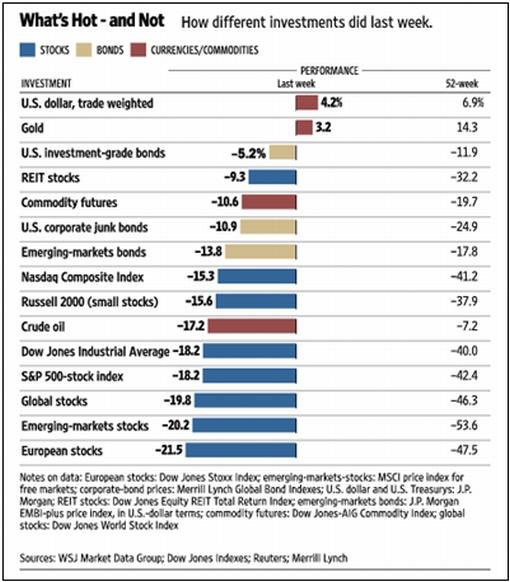
Source: Wall Street Journal Online , October 10, 2008.
Now for a few news items and some words and charts from the investment wise that will hopefully assist in guiding our investment portfolios through these troubled times. And do remember to heed Charles Kirk's ( The Kirk Report ) words: “The best we can do is manage our risk, stay opportunistic, keep our emotions in control, and keep our eyes open for signs that the worst is really behind us.”
That's the way it looks from Cape Town (or rather from next to Lac Léman in Geneva). Au revoir.
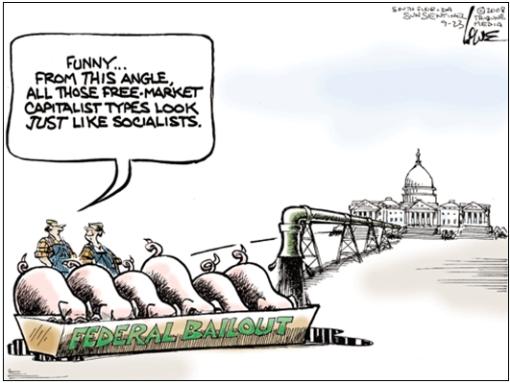
Source: Slate
CNBC: Gloom, Boom and Doom economy
Discussing the market sell-off, with Marc Faber, the Gloom, Boom & Doom Report author.
Source: CNBC , October 7, 2008.
John Authers (Financial Times): Grim anniversary for US equities
“US stocks saw their second worst week on record as markets around the world plunged in an indiscriminate sell-off.”
Source: John Authers, Financial Times , October 10, 2008.
Fox Business: Ron Paul – “Rescue Plan is not good”
Source: Fox Business (via YouTube ), October 10, 2008.
BBC News: Credit crisis – world in turmoil

“As global markets fall sharply, BBC News looks at the regions of the world most affected to see what governments are doing to alleviate the financial turmoil.
“The US Federal Reserve, the European Central Bank, the Bank of England, and the central banks of Canada, Sweden and Switzerland took the unprecedented step on October 8 of co-ordinating a half-point percent cut in interest rates in an effort to ease the credit crunch.”
Click here for the full article.
Source: BBC News , October 9, 2008.
Bloomberg: G-7 commit to “all necessary steps” to stem global meltdown
“Group of Seven finance chiefs, meeting after stocks plunged and as a global recession looms, vowed to prevent the failure of vital banks while failing to unveil new initiatives for thawing credit markets.
“‘The current situation calls for urgent and exceptional action,' the finance ministers and central bankers said in a statement after talks in Washington yesterday. They pledged to ‘take all necessary steps to unfreeze credit and money markets' without detailing how that would be accomplished.
“Signaling they would intervene to avoid a repeat of last month's collapse of Lehman Brothers, the officials promised to ensure major banks have access to cash and are able to tap public funds for capital. By refraining from specific fresh measures such as embracing a UK plan to guarantee loans between banks, they still run a risk of disappointing investors.”
Source: Simon Kennedy, Bloomberg , October 11, 2008.
MarketWatch: US recapitalization plan for financial firms
“As the financial crisis threatens to spiral out of control, US Treasury Secretary Henry Paulson is taking extraordinary steps through the extensive authority granted to him under emergency rescue legislation.
“With the legislation's main mechanism – an auction system to purchase bad mortgage-based securities – still weeks away from implementation, Paulson now plans to make big capital injections into large financial institutions and get equity in return.
“In a news conference Friday evening, following the Group of Seven meeting in Washington, Paulson said the plan is to offer a term sheet for needy banks. The government will not get voting rights status for its injection in most cases. Paulson said the government's efforts were focusing on ‘liquidity' needs and ‘systemic risk'.
“Paulson said recapitalization was now ‘necessary' and would let ‘taxpayer dollars go further', because it is a ‘more efficient' use of capital than the auction process, which is meant to deal with illiquid assets.
“‘This a plan I am quite confident will work,' Paulson said.”
Source: Albert Bozzo, CNBC , October 10, 2008.
Asha Bangalore (Northern Trust): Coordinated Move of Central Banks Necessary But Temporary Panacea
“The Federal Reserve Bank, European Central Bank, Bank of England, Bank of Canada, Swiss National Bank, and Sveriges Riksbank (Bank of Sweden) implemented a coordinated cut of their main policy rates this morning. Excluding the Swiss National Bank, the other central banks reduced the benchmark rates 50 bps.
“The People's Bank of China eased monetary policy 27 bps and the central bank of the United Arab Emirates lowered the repo rate 50 bps, while the Bank of Japan issued a statement of support. Norges Bank (central bank of Norway) sat out today's round but announced it would bring its next policy meeting forward by two weeks, to October 15, when it will ‘consider rates' in the face of recent developments.
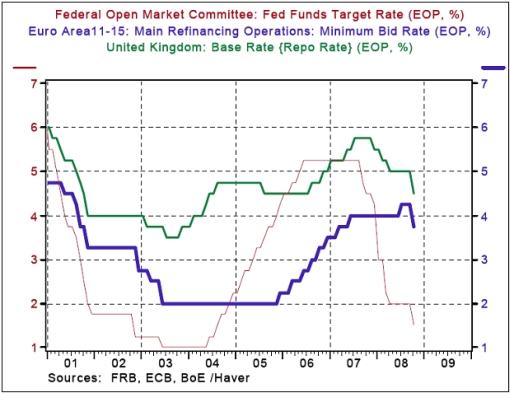
“The most important message from this historic action is that central banks are standing ready to provide liquidity to prevent a systemic implosion of the global financial infrastructure arising from growing perceptions of counterparty risk. The world's major central banks are using all tools at their disposal to prevent a replay of the Great Depression.
“Is today's action the elixir that will fix the wide array of financial and economic problems that have crept across the globe? The honest answer is ‘no'. Are additional coordinated actions likely? Possibly, but the nature of the action will be related to the monetary policy options available to each nation.”
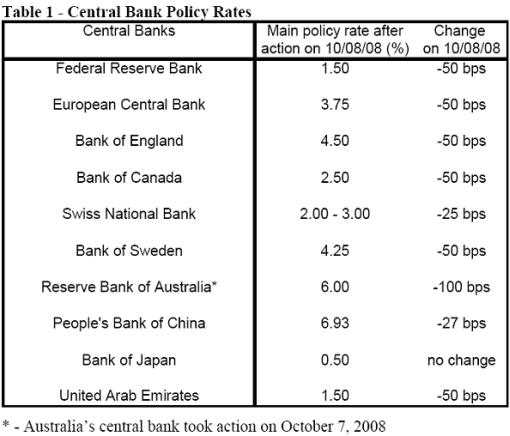
Source: Asha Bangalore, Northern Trust – Daily Global Commentary , October 8, 2008.
Financial Times: Moscow to pump $37 billion into biggest state institutions
“Russia on Tuesday stepped up efforts to tackle the financial crisis with a commitment to pump $37 billion in long-term loans into its biggest state banks, amid signs that the turmoil was spreading to the real economy.
“Even as Dmitry Medvedev, the president, unveiled the plan to offer the five-year loans – mainly through Sberbank, the state-controlled bank – three big Russian companies announced cutbacks in production because of a shortage of finance.
“Investors shrugged off the rescue plan amid mounting fears that the state funding would not find its way to the real economy. A previous state package to boost liquidity by more than $100 billion is being hoarded by the biggest banks instead of being lent out to entities most in need of cash.
“‘The bigger problem is question marks over future growth,' said Chris Weafer, chief strategist at Uralsib investment bank. ”The lack of financial lubrication is causing the economy to grind to a halt. These funds need to be ramrodded into the system.”
Source: Charles Clover and Catherine Belton, Financial Times , October 8, 2008.
Eoin Treacy (Fullermoney): Concerted efforts required to revive confidence
“Central banks and governments are finally coming to the realisation that this is a global crisis and requires a global solution. The simultaneous rate cuts announced this week were a signal that this is now starting to happen. However, investors have lost faith in the ability of the authorities to deal with this problem. It is going to take further concerted efforts to revive confidence and a commitment to tackling the central themes of this crisis, i.e. rising foreclosures and the drying up of liquidity in the money markets.
“The focus of the current panic is that banks are unwilling to lend to one another because they don't trust their counterparties or because they need the cash themselves. If government agencies take shares in their respective banking sectors, thus adding capital, the question will remain outstanding as to whether it is enough. If however, governments guarantee loans made between banks, it will almost certainly get the market moving once more. This approach runs the risk that suspect institutions will survive when they would normally have gone bust. However, given the extreme nature of this crisis, this question of moral hazard is going to be put off for another time.
“The best indicators of liquidity remain the TED spread and the OIS spread. Both made new highs today and remain in accelerating uptrends. The VIX also hit another new high today and further indicates that fear is the overriding emotion gripping investors right now. Stock markets are unlikely to find an important low until these spreads begin to contract.”
Source: Eoin Treacy, Fullermoney , October 10, 2008.
Financial Times: UK Treasury unveils bank rescue
“Britain's largest banks are to be part-nationalised after the government took the momentous decision to pump tens of billions of pounds of public money into the sector to avert a banking collapse.
“The government is to put up to £250 billion into the banking system in an effort to keep banks lending. It will also offer a guarantee to banks issuing medium term debt, which could mean backing a further £250 billion of bank borrowings. But it is likely to demand dividend cuts and the end of big bonuses at the banks in return.
“Under the plan, announced by the Treasury on Wednesday, seven leading banks and the Nationwide Building Society will initially apply for £25 billion in permanent capital to raise their Tier One capital ratios, with a further £25 billion available as a stand-by and for other eligible institutions. The banks have agreed to conclude their recapitalisation by the end of the year.
“The banks involved are Abbey, now part of Santander of Spain, Barclays, HBOS, HSBC, Lloyds TSB, Royal Bank of Scotland and Standard Chartered as well as Nationwide. Other UK banks and building societies are invited to apply for the scheme as well.
“Referring to ‘extraordinary market conditions', the Treasury said it would provide at least £200 billion under its £200 billion special liquidity scheme ‘until markets stabilise'.
“The government will also, for a fee, guarantee new short and medium term debt issues by the banks to help them refinance wholesale funding obligations as they fall due. It said it expected the take up of this guarantee to be of the order of £250 billion.”
Source: Financial Times , October 7, 2008.
Financial Times: Germany guarantees savings to avert panic
“Germany said on Sunday it would guarantee all private German bank accounts – currently worth €568 billion – in a dramatic move to prevent panic withdrawals as fears over he worldwide financial crisis spread to Europe's largest economy.
“‘We want to tell people that their savings are safe,' Angela Merkel, chancellor, said at an unscheduled press conference on Sunday. The scheme would cover existing accounts and others which savers might open.
“German government officials also late on Sunday said the country's commercial banks had agreed to inject an extra €15 billion of liquidity into Hypo Real Estate, the ailing German mortgage and public sector lender, raising the bail-out agreed last week to €50 billion, the largest since the outbreak of the financial crisis. The original rescue attempt had threatened to collapse after it emerged at the weekend that the full extent of Hypo's funding gap had not been disclosed.”
Source: Bertrand Benoit and James Wilson, Financial Times , October 6, 2008.
John Authers (Financial Times): Fed to start buying commercial paper
Click here for the full article.
Source: John Authers, Financial Times , October 7, 2008.
CBS News: Wall Street's shadow market
Steve Kroft looks at some of the arcane Wall Street financial instruments that have magnified the economic crisis.
Click here for the full article.
Source: CBS News , October 5, 2008
Bloomberg: Lehman bondholders get little insight on price from CDS auction
“Lehman Brothers bondholders didn't get a clear indication of how much they will recover in the firm's bankruptcy from an auction of insurance on its debt, two analysts said.
“Yesterday's auction determined that investors who bet on a default of Lehman's debt by buying derivatives called credit default swaps should get 91.375 cents on their dollar. The price was set by auction administrators Creditex Group Inc. and Markit Group Ltd., with 14 financial institutions bidding. That figure was calculated based on an ‘inside market midpoint' price of 8.625 cents on the dollar for Lehman's debt.
“The auction has little to do with what bondholders will recover once Lehman's bankruptcy, filed September 15, has been fought out in court by creditors, said Matt Dundon, managing director of distressed analysis at Miller Tabak Roberts Securities.
“‘I take very little directionality on the ultimate value of the bonds from the CDS auction,' Dundon said.
“Kevin Starke, an analyst with CRT Capital Group LLC said there are too many unknowns so far in the Lehman case to accurately predict recoveries.”
Source: Tiffany Kary, Bloomberg , October 11, 2008.
Reuters: NY Fed calls Friday meeting for CDS players
“The Federal Reserve Bank of New York said on Wednesday it has summoned participants in the $55 trillion credit derivatives market to a meeting on Friday, which sources say will focus on determining which clearing house the market will support.
“Calls for regulation and centralized clearing of credit default swap trades have gathered steam in the wake of Lehman Brothers' failure last month.
“Critics charge that credit default swaps are central to the spreading fears in the markets and pose systemic risks, as the market's private nature makes it impossible to know the size of a counterparty's exposures and where they are distributed.”
Source: Reuters , October 8, 2008.
BCA Research: Policy response – timeliness is key
“In a recent Special Report, we highlight that it took a massive policy response in prior real estate/financial sector crises (e.g. Norway, Sweden, Finland, Japan and the US) before markets stabilized. In fact, in each episode conditions did not stabilize until the vast majority of struggling institutions were supported or dissolved. In three instances the government needed to extend a blanket guarantee for the entire banking system. Moreover, the longer policymakers delayed a sizable bailout package, the greater were the economic and banking sector losses.
“Bottom line: History suggests that a rapid and sizable policy response (that deals with the majority of problem loans) is needed when faced with a banking crisis. Hesitation allows a negative economic feedback loop to develop, ultimately leading to greater cleanup costs. This is already evident in the US and Europe, where recessionary pressures are intensifying.”
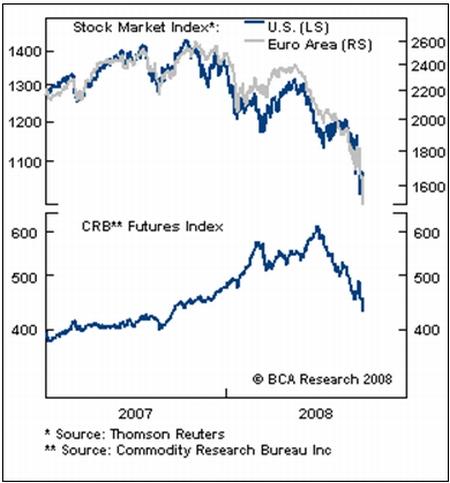
Source: BCA Research , October 6, 2008.
Bloomberg: Treasury to hire asset management firms to jumpstart rescue
“Treasury Secretary Henry Paulson is hiring as many as 10 asset-management companies to join the lawyers and bankers he is recruiting to kickstart the government's new $700 billion bank-rescue program.
“The Treasury began implementing the plan within an hour of Congress yesterday giving Paulson the powers he sought to combat the US financial crisis. Paulson is seeking to assemble a team to determine which toxic securities to target, how to value them and how to buy them. BlackRock, Pimco and Legg Mason are seeking to become money managers for the program, people familiar with the matter said.
“‘This is something that, for a typical company, would take no less than five years,' said Lynn Turner, a former chief accountant at the Securities and Exchange Commission. ‘Anyone who thinks they can do this in two weeks is insane.'
“Ed Forst, the former Goldman Sachs executive Paulson hired to head the transition team, started work last week and is charged with helping establish the new Office of Financial Stability.”
Source: Rebecca Christie and Robert Schmidt, Bloomberg , October 4, 2008.
Financial Times: IMF sees greatest shock since 1930s
“The financial crisis will drive down global economic growth to its lowest since 2002 with a big risk it will drop even further, the International Monetary Fund has warned.
“Though Olivier Blanchard, the fund's chief economist, said that the chance of another Great Depression was ‘nearly nil', the IMF said that the US and European economies were mainly already in or close to recession.
“‘The world economy is now entering a major downturn in the face of the most dangerous shock in mature financial markets since the 1930s,' the IMF said. ‘The situation is exceptionally uncertain and subject to considerable downside risks.'
“The fund said that global growth was likely to slow to 3.9% in 2008 and 3% in 2009, sharply down from 5% last year. Some economists regard 3% or 2.5% global growth as equivalent to a world recession, given the trend rates of growth in the global economy, but Mr Blanchard said that such definitions were unhelpful.
“The IMF chief economist's optimism that the world would avoid a repeat of the Great Depression of the 1930s was based on an expectation that governments would follow the right policies. European governments were having difficulty in coordinating their response to the crisis and more action was needed to shore up their shaky financial systems, he said.”
Source: Alan Beattie, Financial Times , October 8, 2008.
CNBC: Lazear on the global economy
“Discussing the market slide and the $700 billion bailout package with Edward Lazear, Chairman of the Council of Economic Advisers.”
Source: CNBC , October 7, 2008.
Barry Ritholtz (The Big Picture): Fix the credit problem, not its symptoms
“Why are markets reacting so negatively to a near $1 trillion bailout? The short answer is that the Federal Reserve and the Treasury Department have been focusing on the wrong issues. They have been treating falling asset prices – a houses, stocks, bonds – as well as the lack of confidence between banks, as the actual issue. This is the wrong approach. Falling asset prices and a lack of confidence are a result of the underlying problem . You don't cure alcoholism by getting rid of a hangover; you cannot resolve confidence issues by merely cutting rates.
“The primary problem is that banks are refusing to extend credit to each other. Why? Because they do not understand the liabilities of their counterparties. Translated into English, that means they don't know if the other bank whom they are dealing with will still to be standing tomorrow.
“The thing roiling markets today is not the lack of confidence; It is capital, or more accurately, the lack thereof. Thanks to a series of very poor trades – excessively leveraged and absurdly risky to boot – banks are now dramatically undercapitalized.
“As we have seen in just about every historical financial crisis, the shortage of capital is the underlying cause of monetary mayhem. Too much debt, too little equity, makes any financial system cease to function.
“So what would solve it? The first step to accomplish this is triage. Identify the banks that cannot survive, and like Old Yeller, ‘gently' put them down. Euthanize the bad ones so the good ones can survive. Nationalize 'em, sell their accounts to strong banks, and prevent further liabilities to the FDIC (which insures all accounts up to $250,000).
“Next, recapitalize the banks that can survive by buying preferred stock. That is what Warren Buffett did with General Electric and Goldman Sachs when he made his investments. The Treasury should announce a matching program, where any private investment into a Bank is matched by the government, dollar for dollar, and on the same terms. This fixes not merely a balance sheet issue (like TARP does) but the actual capital structure at the root of the current crisis. And it does so on terms that are good for the taxpayers too.
“As this process eliminates the bad banks and recapitalizes the good banks, normal lending will resume. Defaults and insolvency will no longer paralyze the financial industry. This is how Sweden resolved its financial crisis in the nineties, and how England just started to address their problem this past week.
“The good news is that the US is that there are signs the US is starting to move towards the Swedish / British / Buffett model. The bad news is that it has taken this long to even begin contemplating this.
“When banks know their counterparties are not in danger of going belly up tomorrow, they will begin lending again. Confidence will return once the underlying problem is resolved, and not a minute before.”
Source: Barry Ritholtz, The Big Picture , October 10, 2008.
Richard Russell (Dow Theory Letters): Fiat empire – Why the Fed violates the US Constitution
Source: Richard Russell, Dow Theory Letters , October 6, 2008.
Did you enjoy this post? If so, click here to subscribe to updates to Investment Postcards from Cape Town by e-mail.
By Dr Prieur du Plessis
Dr Prieur du Plessis is an investment professional with 25 years' experience in investment research and portfolio management.
More than 1200 of his articles on investment-related topics have been published in various regular newspaper, journal and Internet columns (including his blog, Investment Postcards from Cape Town : www.investmentpostcards.com ). He has also published a book, Financial Basics: Investment.
Prieur is chairman and principal shareholder of South African-based Plexus Asset Management , which he founded in 1995. The group conducts investment management, investment consulting, private equity and real estate activities in South Africa and other African countries.
Plexus is the South African partner of John Mauldin , Dallas-based author of the popular Thoughts from the Frontline newsletter, and also has an exclusive licensing agreement with California-based Research Affiliates for managing and distributing its enhanced Fundamental Index™ methodology in the Pan-African area.
Prieur is 53 years old and live with his wife, television producer and presenter Isabel Verwey, and two children in Cape Town , South Africa . His leisure activities include long-distance running, traveling, reading and motor-cycling.
Copyright © 2008 by Prieur du Plessis - All rights reserved.
Disclaimer: The above is a matter of opinion and is not intended as investment advice. Information and analysis above are derived from sources and utilizing methods believed reliable, but we cannot accept responsibility for any trading losses you may incur as a result of this analysis. Do your own due diligence.
Prieur du Plessis Archive |
© 2005-2022 http://www.MarketOracle.co.uk - The Market Oracle is a FREE Daily Financial Markets Analysis & Forecasting online publication.



